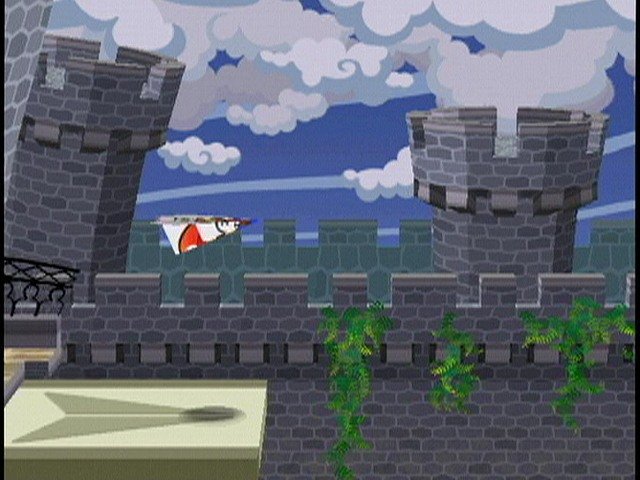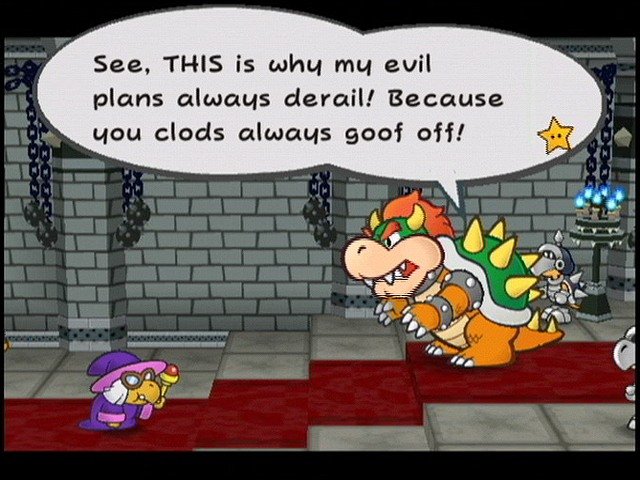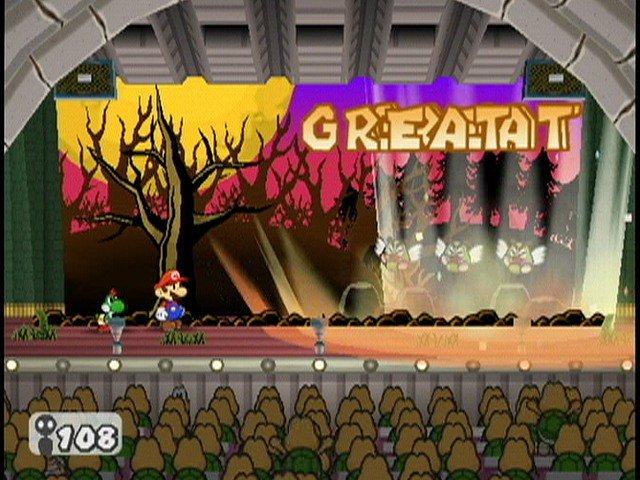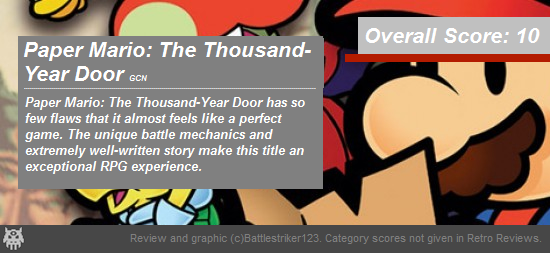Let's look back at one of the greatest titles on the GameCube.
Wow.
It's a game that strikes a good impression right when you start, and doesn't stop until the very end. It's a game full of surprises, in both gameplay mechanics and story narration. It has amazing music, a distinctive style, and comical effects to match. In many ways, this game is flawless.
Oops. Am I going too fast? I'm so sorry. I couldn't help myself. The game is good. No, I mean too good. Oops, got ahead of myself again. Silly me. *Ahem* Okay. Introduction.
Paper Mario started out with a strange concept. The first game was an RPG, made entirely on a paper, built for a console that emphasized 3D. But from a bizarre concept came a wonderful and delightful of an RPG experience, one that still stands as one of the most charming games to date, even thought it had a few flaws. Thus, Intelligent Systems began working on a sequel to fix the game up and improve on the existing formula, creating a fantastic game that delivers exactly what was on paper (excuse my pun). Here's why.

Transform into anything and everything!
The story is unforgettable, comparable to a really, really good book (and, in a way, it is a book, complete with a prologue and eight complete chapters) . The Thousand-Year Door follows our favorite plumber Mario as he travels across the Mushroom Kingdom in search of the Crystal Stars in an effort to save Princess Peach and, of course, the world. It's a long and complicated story, split up into multiple threads that follow the adventures of Mario, Peach, and even Bowser, totaling over an impressive 25+ hours of gameplay (completionists may even take up to 40 hours to complete the game). Though the story itself may be confusing at first, as the game progresses, everything falls into place.
It's immediately apparent by the opening cut-scene that you're going to be in for a unique experience. And what you'll get is nothing short of just that. As you may have guessed, everything in the game is made out of paper. Even Mario is made out of paper, which allows him to bend and fold in ways that the "real" Mario could never do. You'll transform into paper planes, "tear off" parts of the screen, and rip holes through the background to destroy enemies. Yep, "unique" is definitely the best way to describe TTYD's visual style.
And speaking of style, TTYD packs A LOT of personality. Each and every character has a unique way of saying things that give everyone, even NPC's, a distinct personality. You'll also find that the way each character animates differently as well, which shows how much detail and work was put into this game. The scripts themselves are funny and humorous, and I wouldn't be surprised if a professional writer actually helped the team at Intelligent Systems created them. The game's presentation is seriously over the top.

Bowser&#Array;s getting a little pissy here...
Of course, what is Paper Mario without the RPG elements? The game plays like your normal turn-based RPG, with every battle beginning when Mario comes in contact with an enemy in the overworld (which means, yes, no random encounters). You and your partner of choice (you'll meet plenty of them on your travels) then take turns attacking your enemy (or enemies), after which the enemies begin attacking immediately following the completion of your turn. During your turn, you can choose from a variety of different actions, including using normal attacks, using special attacks, using items, or running away. Each action is accompanied by a series of button commands that are required to execute the action (e.g. tilt the analogue stick back to charge your hammer). Sounds like your average RPG, right? Nope, you're wrong.
The battle system is surprisingly more than what meets the eye. You see, your battles take place on a stage (like, in a stage play), with your audience compromised of different individuals from the Marioverse. Occasionally, they'll trigger random events, like throw items at you or run back-stage to drop stage props onto your head. And did I mention that while you're battling, you're also playing a lottery that can both help and hurt you in battle? Did you know that the stage's backdrop will sometimes fall onto your head? It's small things like these that make TTYD more than just your average RPG. In fact, they make TTYD succeed in a way that many modern RPG's have been struggling to accomplish: they make battles feel less tedious and more fun.

More than what meets the eye.
I think it's appropriate to end this retro review with the game's music. The music is well done. That's all. Really, go listen to it yourself. The catchy tunes and classic remixes really get to your heart and, may I say, your soul. Don't believe me? Listen to the soundtrack yourself.
Of course, there is no such thing as a perfect game, so I have no choice but to be nit-picky here. The only thing that annoys me a bit is the amount of dialogue and cut-scenes scattered throughout the game. Though many of these scenes are meant to advance the game's story, much of it feels unnecessary, sometimes even becoming frustrating, especially when you die and you're forced to watch everything all over again. But that's just a small thing that is easily overlooked in this otherwise flawless game.
Flawless? Did I just say that? I think I did.
Paper Mario: The Thousand-Year Door is an amazing game. There is nothing in particular that significantly detracts from this wonderful experience. The battle system is unique. The story is madly enjoyable. The style is so charming. The music is absolutely beautiful. Did I miss something? Oh yes, a score.
I really can't praise this game enough. Everyone should give it a shot. It's so good. No, not just good. It's now one of my favorite games ever. Yeah, I said it. Perfect? Debatable. Amazing? Absolutely.
How did you like Paper Mario: The Thousand-Year Door?
![Amazing Spider-Man Finale Features New [SPOILER] Costume](../../../../../../assets1.ignimgs.com/2018/06/01/untitled-br-1527892808294_small.jpg)
